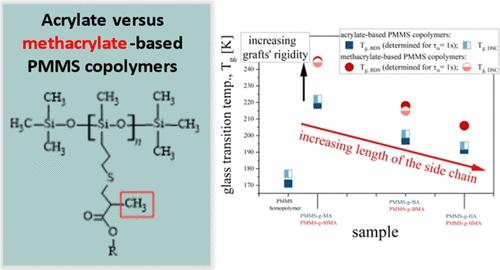当前位置:
X-MOL 学术
›
Macromolecules
›
论文详情
Our official English website, www.x-mol.net, welcomes your
feedback! (Note: you will need to create a separate account there.)
The Influence of Graft Rigidity on the Dynamical Behavior of PMMS-Based Polymer Brushes at Ambient and High Pressures
Macromolecules ( IF 5.1 ) Pub Date : 2024-11-15 , DOI: 10.1021/acs.macromol.4c01779 Sara Zimny, Magdalena Tarnacka, Paulina Maksym, Żaneta Wojnarowska, Marian Paluch, Kamil Kamiński
Macromolecules ( IF 5.1 ) Pub Date : 2024-11-15 , DOI: 10.1021/acs.macromol.4c01779 Sara Zimny, Magdalena Tarnacka, Paulina Maksym, Żaneta Wojnarowska, Marian Paluch, Kamil Kamiński

|
In this paper, we investigated the molecular dynamics of polymer brushes based on poly(mercaptopropyl)methylsiloxane (PMMS), in which the thiol group was grafted with different homologous flexible acrylates (acrylate-based PMMS copolymers) and more rigid methacrylate (methacrylate-based PMMS copolymers) monomers of varying lengths of alkyl chain under ambient and elevated pressure conditions. It was found that the glass transition temperature, Tg, of PMMS homopolymer is significantly lower compared to the other systems. Moreover, surprisingly, in the methacrylate-grafted copolymers, there are two relaxation processes (α and α′), while in the systems grafted with various acrylates, only a single process is present in the supercooled phase. Complementary rheological investigations indicated that the faster α process comes from the segmental motions, while α′ is not detected in the mechanical response. Further high-pressure experiments showed that there is a superposition between segmental and α′ modes irrespective of applied pressure, p, in methacrylate-based PMMS copolymers. This result suggests that the latter process might be considered as a sub-Rouse mode, or alternatively, it may originate from the dielectric active relaxation of the rigid polar side chain (grafts). Moreover, analysis of the high-pressure data allowed us to estimate the pressure coefficient of the glass transition temperature, dTg/dp, which was much higher for polymer brushes with respect to the PMMS homopolymer. Interestingly, the values of dTg/dp for methacrylate-grafted copolymers are slightly higher compared to acrylate-based PMMS copolymers, which may be due to the different flexibility/rigidity of both groups of materials as all examined materials have the same degree of polymerization of homopolymer backbone (Nbb ∼ 12) and side chain (Nsc = 1). However, for both groups of studied systems, dTg/dp values did not scale with chain length. This unexpected result must be related to the structure of the studied grafted copolymers and the character of grafts, derivatives of acrylates/methacrylates. The data presented here extend our knowledge of the influence of the architecture of different molecules on the dynamics of polymers at ambient and high pressures.
中文翻译:

接枝刚度对基于 PMMS 的聚合物刷在环境和高压下动力学行为的影响
在本文中,我们研究了基于聚巯基丙基)甲基硅氧烷 (PMMS) 的聚合物刷的分子动力学,其中巯基与不同烷基链长度的不同同源柔性丙烯酸酯(丙烯酸酯基 PMMS 共聚物)和更坚硬的甲基丙烯酸酯(甲基丙烯酸酯基 PMMS 共聚物)单体接枝在环境和高压条件下烷基链长度不同。研究发现,与其他系统相比,PMMS 均聚物的玻璃化转变温度 Tg 显著降低。此外,令人惊讶的是,在甲基丙烯酸酯接枝共聚物中,有两个弛豫过程(α 和 α′),而在用各种丙烯酸酯接枝的系统中,过冷相中仅存在一个过程。互补流变学研究表明,更快的 α 过程来自节段运动,而在机械响应中未检测到 α'。进一步的高压实验表明,在甲基丙烯酸酯基 PMMS 共聚物中,无论施加的压力 p 如何,分段模式和 α' 模式之间存在叠加。这一结果表明,后一个过程可能被认为是亚 Rouse 模式,或者它可能源于刚性极性侧链(接枝)的介电主动弛豫。此外,对高压数据的分析使我们能够估计玻璃化转变温度的压力系数 dTg/dp,相对于 PMMS 均聚物,聚合物电刷的压力系数要高得多。 有趣的是,与丙烯酸酯基 PMMS 共聚物相比,甲基丙烯酸酯接枝共聚物的 dTg/dp 值略高,这可能是由于两组材料的柔韧性/刚度不同,因为所有研究的材料都具有相同的均聚物主链 (Nbb ∼ 12) 和侧链 (Nsc = 1) 的聚合度。然而,对于两组研究的系统,dTg/dp 值不随链长缩放。这个意想不到的结果必须与所研究的接枝共聚物的结构以及接枝物、丙烯酸酯/甲基丙烯酸酯衍生物的特性有关。这里提供的数据扩展了我们对不同分子的结构对环境和高压下聚合物动力学影响的了解。
更新日期:2024-11-16
中文翻译:

接枝刚度对基于 PMMS 的聚合物刷在环境和高压下动力学行为的影响
在本文中,我们研究了基于聚巯基丙基)甲基硅氧烷 (PMMS) 的聚合物刷的分子动力学,其中巯基与不同烷基链长度的不同同源柔性丙烯酸酯(丙烯酸酯基 PMMS 共聚物)和更坚硬的甲基丙烯酸酯(甲基丙烯酸酯基 PMMS 共聚物)单体接枝在环境和高压条件下烷基链长度不同。研究发现,与其他系统相比,PMMS 均聚物的玻璃化转变温度 Tg 显著降低。此外,令人惊讶的是,在甲基丙烯酸酯接枝共聚物中,有两个弛豫过程(α 和 α′),而在用各种丙烯酸酯接枝的系统中,过冷相中仅存在一个过程。互补流变学研究表明,更快的 α 过程来自节段运动,而在机械响应中未检测到 α'。进一步的高压实验表明,在甲基丙烯酸酯基 PMMS 共聚物中,无论施加的压力 p 如何,分段模式和 α' 模式之间存在叠加。这一结果表明,后一个过程可能被认为是亚 Rouse 模式,或者它可能源于刚性极性侧链(接枝)的介电主动弛豫。此外,对高压数据的分析使我们能够估计玻璃化转变温度的压力系数 dTg/dp,相对于 PMMS 均聚物,聚合物电刷的压力系数要高得多。 有趣的是,与丙烯酸酯基 PMMS 共聚物相比,甲基丙烯酸酯接枝共聚物的 dTg/dp 值略高,这可能是由于两组材料的柔韧性/刚度不同,因为所有研究的材料都具有相同的均聚物主链 (Nbb ∼ 12) 和侧链 (Nsc = 1) 的聚合度。然而,对于两组研究的系统,dTg/dp 值不随链长缩放。这个意想不到的结果必须与所研究的接枝共聚物的结构以及接枝物、丙烯酸酯/甲基丙烯酸酯衍生物的特性有关。这里提供的数据扩展了我们对不同分子的结构对环境和高压下聚合物动力学影响的了解。


















































 京公网安备 11010802027423号
京公网安备 11010802027423号